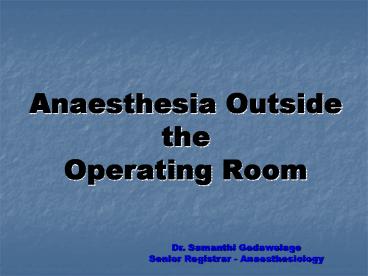Anaesthesia Outside the Operating Room Dr. Samanthi - PowerPoint PPT Presentation
1 / 19
Title:
Anaesthesia Outside the Operating Room Dr. Samanthi
Description:
Anaesthesia Outside the Operating Room Dr. Samanthi Godawelage Senior Registrar - Anaesthesiology -Radiology Dept -Cardioversion -ECT -Dental Anaesthesia Problems ... – PowerPoint PPT presentation
Number of Views:1009
Avg rating:3.0/5.0
Title: Anaesthesia Outside the Operating Room Dr. Samanthi
1
Anaesthesia Outside the Operating Room
Dr. Samanthi GodawelageSenior Registrar -
Anaesthesiology
2
-Radiology Dept -Cardioversion -ECT
-Dental Anaesthesia
3
Problems related to isolated environment
- Equipment might be old, not regularly serviced
and not in standard use as in the rest of the
hospital - Monitoring standards may not be adequate
- Piped medical gases may not be supplied
- Other personnel may be unaware of the problems
facing the anaesthetist - Space may be limited by bully equipment making
access to the patient difficult - Poor environmental conditions (eg Lighting,
temperature) - Recovery facilities may not be available
- Inadequate ventilation/scavenging causing
pollution - Problem related to transferring patients
4
Problems related to patient
- Patients who require general anaesthesia are
- Infants or uncooperative children
- Older children or adults with psychological
behavioural or movement disorders - Intubated patients such as acute trauma victims
and patients receiving intensive care - Interventional procedures radio-guidance or
painful procedures like ECT, cardioversion which
require amnesia
5
Problems related to the procedure
- MRI related problems
- Bleeding
- Conversion from sedation to anaesthesia
- Contrast related problems
- Radiation
6
Anaesthetist may be asked to administer lV
contrast to the patient
- Check the timing of injection with the
radiographer - Contrast is viscous and can be difficult to
inject - Automated contrast injectors can cause high
pressures to be developed - Reactions
- Renal effects
- Oral contrast can cause aspiration
7
Anaesthesia for CT
8
- Anaesthetist can remain in the room wearing X-ray
protection or view the patient and monitors from
the control room - The CT scanner does not interfere with monitoring
equipment, but.. - The scans are short and can be interrupted
- The patient couch moves during examination
- Temporarily interruption of ventilation to
improve image quality immediately re-ventilate - Patient positioning
9
Anaesthesia for MRI
10
- MRI has superceded CT for the examination of CNS
and many orthopaedic conditions - MRI uses a static magnetic field which is
permanently on and super-imposed rapidly changing
magnetic fields and radio-frequency currents - Low ionising radiation is used and there are no
known ill effects - Everyone must be screened before entering
magnetic area and all ferro-magnetic items
removed - MRI can last over an hour and an individual scan
can last upto 20 minutes
11
MRI poses several unique problems to the
anaesthetist
12
- High magnetic field which is always on
- The bore of the magnet is narrow, noisy and
claustrophobic. Access to the patient is
difficult so air-way must be secured - Monitoring equipment can introduce stray
radiofrequency current causing degradation of the
image - The magnetic fields and radiofrequency currents
interfere with monitoring. Currents induced in
leads can cause burns
13
Solutions for MRI Anaesthesia
14
- MRI compatible anaesthetic equipment or
anaesthetic equipment kept outside the magnetic
field - Monitoring during MRI
- To minimize interference, use of Faraday cage and
low band filters - ECG the ECG is distorted by the magnetic field
due to currents induced on leads - Pulse oxymetry-prone to interference and burns
- Capnography- for monitoring of adequacy of
ventilation and as a disconnect alarm - Blood pressure-automated blood pressure
recording can be performed using extended cable
and nylon threads on cuff attachment. Invasive
blood pressure measurements need long extension
tubing
15
- Anaesthesia for ECT
- Electroconvulsive therapy (ECT) is an effective
treatment for severe depression often not
responding to drug treatment - General anaethesia is used to provide a brief
period of amnesia and modify the motor effects of
the seizure to protect the patient - Physiologic effects of ECT
- Electrical stimulus- brief period of muscular
contraction followed by the tonic and then clonic
phases of the seizures - Cardiovascular effects of ECT- immediate
parasympathetic response followed within seconds
by a sympathetic response - The muscular activity of the seizure and the
increased sympathetic activity causes a rise in
myocardial oxygen consumption, increases CMRO2,
cerebral blood flow, intracranial, intra-ocular
intra-gastric pressure briefly
16
- Contraindications
- Recent myocardial infarction, intracranial
pathology - Anaesthetic management
- Many have medical problems
- Effects of long term psychotropic drugs
- An appropriate period of fasting is difficult to
guaranty - Patients may already have had several
anaesthetics - Pre-oxygenation and IV access
- Induction agent
- Sux to reduce muscle contraction
- 100 O2 till spontaneous breathing resumes
17
Anaesthesia for Cardioversion
18
- Elective Cardioversion
- Adequate fasting and IV access.
- Emergency Cardioversion
- Haemodynamically compromised patient
- un-fasted patient
- Dose of induction agent should be adequate
- To obtund the hypertensive response to intubation
- But care must be taken not to compromise the
blood pressure further
19
Thank You

